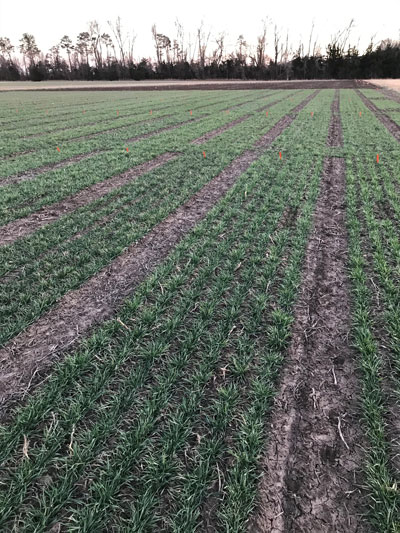Fall forage yield is an important aspect of dual-purpose wheat production. In this system, wheat is typically sown earlier than for grain only production, at higher seeding rates and with additional nitrogen fertilizer to maximize forage production.
The weather experienced during the fall is crucial to determine average level of forage yield, with warm and moist weather typically resulting in greater forage yield than cool and dry weather conditions. Management practices that also maximize forage yield are early sowing, higher seeding rates, placement of in-furrow phosphorus fertilizer with the seed at sowing, and fall nitrogen fertilization.
While the weather is typically the largest player in determining fall forage production, followed by management, there are also differences among wheat varieties in forage production potential. Thus, every year, the K-State Wheat Production Group compares the forage yield of several commonly grown wheat varieties and upcoming lines. This test is usually performed in the South Central Experimental Field near Hutchinson, Kansas (Figure 1), and the forage sampling occurs sometime in December (Table 1).

Figure 1. Dual-purpose wheat trial near Hutchinson, KS. The trial was sown on September 17, 2020, with 50 lbs DAP/acre applied in furrow, and 90 lbs N/acre broadcast incorporated prior to sowing. Photo by Romulo Lollato, K-State Research and Extension.
At the sampling conducted on December 22, 2020, there were no significant differences in fall forage yield among the 34 wheat varieties tested. Average forage yield was low, ranging from 470 to 1,058 pounds of dry matter per acre and averaging 737 pounds of dry matter per acre. While the numerical differences between some varieties seem large, we highlight that these differences were not significant. This low forage production was a function of the combination of an extremely dry fall, which had enough moisture for a good germination and crop establishment (Figure 1) however with limited subsequent moisture (total of ~3 inches between sowing and forage measurement) and low temperatures (average 49°F). The dry and cool conditions experienced during the fall did not allow for much forage biomass production, which was reflected in the measurements shown in Table 1.
Another important aspect of dual-purpose wheat production is how long each variety can be grazed in the spring. This is measured as the date for first hollow stem, and varieties can differ in as much as 20-30 days in achieving first hollow stem in the spring. The Wheat Production Group at K-State uses this very same trial to measured first hollow stem during late February and early March, so stay tuned to the eUpdate for updates on first hollow stem progression among our wheat trials.
Table 1. Fall forage yield of wheat varieties sown under a dual-purpose system near Hutchinson, KS. Forage biomass was collected on December 22, 2020. Data is shown in pounds of dry matter per acre (lbs DM/ac). There were no statistically significant differences among the varieties evaluated. Varieties are ordered alphabetically.
|
Variety |
Forage dry matter (12/22/2020) |
|
------- lbs DM/ac ------- |
|
|
10BC329-17-5 |
714 |
|
AP EverRock |
733 |
|
AP Roadrunner |
858 |
|
Buckhorn AX |
1058 |
|
Canvas |
782 |
|
Crescent AX |
704 |
|
High Country |
789 |
|
KS12DH0156-88 |
851 |
|
KS13DH0041-35 |
773 |
|
KS Dallas |
601 |
|
KS Hamilton |
758 |
|
KS Hatchett |
829 |
|
KS Silverado |
664 |
|
KS Western Star |
720 |
|
LCS Atomic AX |
532 |
|
LCS Helix AX |
679 |
|
LCS Julep |
952 |
|
LCS Photon AX |
735 |
|
LCS Revere |
833 |
|
Long Branch |
723 |
|
MS Maverick |
729 |
|
NUSAKA15-3 |
808 |
|
OCW04S717T-6W |
751 |
|
OK12912C-138407-2 |
739 |
|
OK16D101089 |
952 |
|
OK Corral |
839 |
|
Paradise |
470 |
|
Rock Star |
745 |
|
Showdown |
548 |
|
Smiths Gold |
711 |
|
WB4269 |
654 |
|
WB4401 |
554 |
|
WB4699 |
642 |
|
Zenda |
620 |
|
Average |
737 |
|
Minimum |
470 |
|
Maximum |
1058 |
Romulo Lollato, Extension Wheat and Forages Specialist
lollato@ksu.edu
Roberta Rebesquini, Visiting Undergraduate Scholar
rbr@ksu.edu